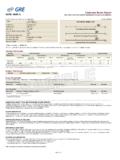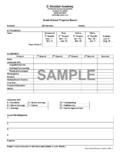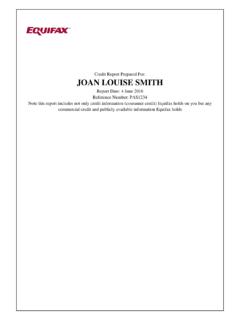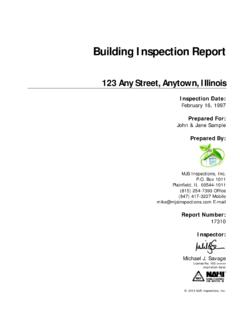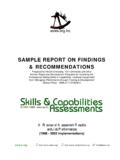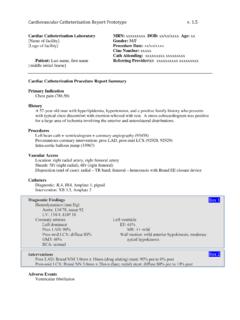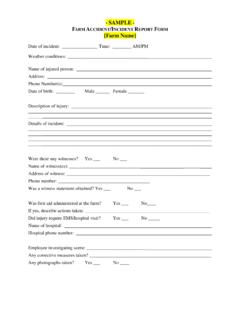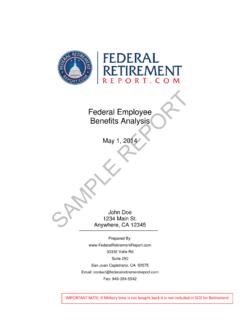Transcription of Sample Final Incident Investigation Report Final Incident ...
1 Sample Final Incident Investigation Report Final Incident Investigation Report for Ammonia Release on XX/XX/XXXX. Summary: A ammonia release occurred on XX/XX/XXXX at 10:00 PM from an ammonia unloading station at the ABC, Inc. production facility. Approximately 100 pounds of ammonia were released into the air over a ten minute period. The ammonia release was stopped by activating the emergency ammonia shutdown system. One operator was exposed to the ammonia fumes but did not require medical treatment. The LEPC, SERC, and NRC were notified by 10:30 PM. The Incident Investigation began at 10:35 PM. The ARCHIE program was run at 10:45 PM. and did not predict an ammonia concentration above the PEL at the nearest public receptor. The release did not require an evacuation of the local community; however, if ammonia exposure is noted, please consult the attached MSDS for anhydrous ammonia for medical treatment advice.
2 The main cause of the Incident was the failure of a gasket in the unloading hose. As a recommendation, the facility will evaluate an alternate gasket type. Also, the inspection cycle of the hoses was changed from monthly to weekly inspections. The emergency shutdown system will also be made more accessible to the operator. Incident Description: At approximately 9:55 PM, the unloading operator connected a hose to an ammonia tank trailer and activated the ammonia unloading pump. About 30. seconds after start of the pump, the hose failed initiating the release of ammonia. The operator was exposed to ammonia fumes but was able to activate the ammonia shutdown system. The release continued for about nine more minutes as residual ammonia between the shutdown valves escaped. An operator nearby notified the shift leader at about 10:10 PM and informed him of the release.
3 The shift leader notified the LEPC, SERC, and NRC. At this time, the shift leader estimated the release to be about 150 pounds. After notifying the agencies, the shift leader ran the ARCHIE program to more accurately determine the quantity released and determined the distance to the concentration representing the TWA of ammonia. The shift leader determined that the concentration of ammonia was below the TWA at the plant boundary closest to the release (assuming the worst case that the wind was blowing in that direction). The revised estimate of the ammonia release was 100 pounds. This was calculated by first calculating the release of ammonia at the system pressure through a inch diameter orifice for approximately one minute. This amount @ Copyright 2002. All Rights Reserved. Contact: was added to the quantity of residual ammonia known to be in the system, at emergency shutdown, between the valves.
4 The unloading operator was checked by a plant first aid responder for ammonia exposure systems. It was determined that the operator did not need further medical treatment. After the Incident was over, the scene was isolated. Photos were made of the unloading hose and gasket. The inventory of ammonia was noted in the tank trailer and storage tank. The initial Investigation was concluded at approximately 11:45 PM. A main Investigation committee was convened the next day to analyze this Incident in further detail. Analysis and Conclusions: The committee decided to use change analysis because this was an operation with a long history and good data records. Several incidents were noted in the past two years releasing small amounts of ammonia that were correlated with bad gaskets at later inspections. Other possible causes were considered but the data did not indicate these cause ammonia releases and were rejected.
5 A. similar unloading process was noted at the company's sister facility in a different state. There were some differences in pump design, but the sister facility uses a higher pressure pump. The gasket design is also different. The sister facility had a much lower gasket failure rate per hour of use. This led the committee to conclude that the gasket design was the main cause. The committee also examined the ammonia exposure to the employee. It was learned that the operator had to walk 40 feet get to the shutoff switch which increased his exposure to the ammonia. It was decided that the exposure could have been greatly reduced if the shutdown switch were located near the pump start button. Recommendations: Recommend that the facility evaluate other types of gaskets and consider the gasket used by the sister facility - RRS# 667.
6 Recommend that the facility immediately increase gaskets inspection to once weekly instead of once monthly - RRS# 668. Move shutdown switch to location adjacent to the pump start switch. - RRS# 669. Contact: Joe Public, ABC Inc., Environmental Coordinator, Ph# xxx-xxx- xxxx @ Copyright 2002. All Rights Reserved. Contact: @ Copyright 2002. All Rights Reserved. Contact.
